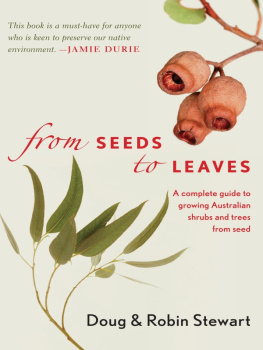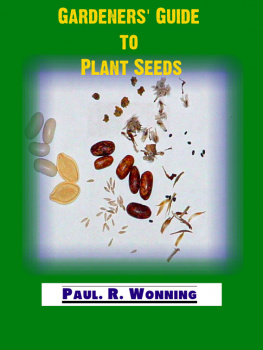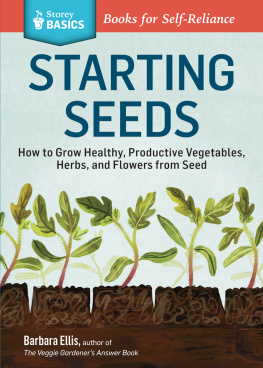THE COMPLETE GUIDE TO
SAVING SEEDS
The mission of Storey Publishing is to serve our customers by publishing practical information that encourages personal independence in harmony with the environment.
Edited by Gwen Steege and Fern Marshall Bradley
Art direction and book design by Cynthia N. McFarland
Cover photography by Rosemary Kautzky: back cover and spine; GAP Photos, Ltd., Fiona McLeod: front cover top; GAP Photos, Ltd., Jo Whitworth: front cover top
Interior photography by Rosemary Kautzky, except for Cheryl Moore-Gough: 1 bottom, 15 bottom left and right, 23 right; Mars Viluabi: 20; Joe De Sciose: 105; H. Zell/Wikimedia Commons: 109; Ada Roth/agefotostock.com: 127; J. Kottmann/agefotostock.com: 140; Philip Nealey/agefotostock.com: 142; StockFood LBRF/agefotostock.com: 148; Enrico Blasutto/Wikimedia Commons: 155; Kristina DeWees/agefotostock.com: 183; Alfred Osterloh/agefotostock.com: 193; Creativ Studio Heinem/agefotostock.com: 268; Maria Kemp/agefotostock.com: 271; Siepmann/agefotostock.com: 276
Illustrations by Beverley Duncan: 13, 14, 16, 17, 21, 22, 29, 63, 75, 83, 129, and 131, and Alison Kolesar: 28, 29, 30, 41, 46, 47, 72, and 79
Indexed by Christine Lindemer, Boston Road Communications
2011 by Bob Gough and Cheryl Moore-Gough
All rights reserved. No part of this book may be reproduced without written permission from the publisher, except by a reviewer who may quote brief passages or reproduce illustrations in a review with appropriate credits; nor may any part of this book be reproduced, stored in a retrieval system, or transmitted in any form or by any means electronic, mechanical, photocopying, recording, or other without written permission from the publisher.
The information in this book is true and complete to the best of our knowledge. All recommendations are made without guarantee on the part of the author or Storey Publishing. The author and publisher disclaim any liability in connection with the use of this information.
Storey books are available for special premium and promotional uses and for customized editions. For further information, please call 1-800-793-9396.
Storey Publishing
210 MASS MoCA Way
North Adams, MA 01247
www.storey.com
Printed in the United States by Quad/Graphics
10 9 8 7 6 5 4 3 2 1
LIBRARY OF CONGRESS CATALOGING-IN-PUBLICATION DATA
Gough, Robert E. (Robert Edward)
The complete guide to saving seeds / by Robert Gough and Cheryl Moore-Gough.
p. cm.
Includes index.
ISBN 978-1-60342-574-2 (pbk. : alk. paper)
1. Seeds. 2. SeedsHarvesting. 3. SeedsViability. 4. Plant propagation.
I. Moore-Gough, Cheryl. II. Title.
SB118.3.G68 2011
631.521dc22
2010051179
THE COMPLETE GUIDE TO
SAVING SEEDS
VEGETABLES, HERBS, FLOWERS, FRUITS, TREES, AND SHRUBS
ROBERT GOUGH and CHERYL MOORE-GOUGH

CONTENTS

To our parents and grandparents, who inspired us, and to our children and grandchildren, who will benefit from their wisdom
Bad seed is a robbery of the worst kind: for your pocket-book not only suffers by it, but your preparations are lost and a season passes away unimproved.
George Washington
THE SEED-SAVING REVIVAL
WELCOME TO THE DYNAMIC and wonderful world of seeds. Nature has excelled at saving seeds for millions of years, but improving upon natural systems is part of human nature. We have done well by probing the mysteries of seeds, learning how to harvest and store them and coax them to germinate and grow abundantly to suit our needs.
A bit more than 10,000 years ago, humankind learned that saving seeds and planting them in specially prepared gardens meant that we no longer had to wander through muddy slime in warm Mediterranean swamps to gather celery, nor did we have to stalk wild cabbages along the cold and windy Baltic coast. Thanks to sojourning pioneers who plied ancient trade routes and returned to Europe with seeds of a strange new tree, we no longer had to live in Kazakhstan to enjoy wild apples.
Seed saving and agriculture birthed civilizations. By planting seeds, humans could more easily enjoy more types of food in greater quantity, which left them more leisure time for developing art and astronomy, music and mathematics. Early gardeners quickly began to understand that if they sowed seeds of, for example, spinach, each plant that sprouted displayed a slight variation in the traits of its parent, while still conserving the overall attributes of spinach. The gardeners observed variations on a theme, so to speak, noticing a few plants with a more tender or larger leaf, while some other plants were more or less robust than the rest. These first generations of seed savers kept the seeds only from the best plants and destroyed plants with less desirable traits (a process called rogueing). Through the hundreds of generations of gardeners and horticulturists that followed, modern seed-saving techniques were refined and ambitious plant-breeding programs flourished. Thus, in the course of only a few thousand years, our collective seed-saving endeavors have accomplished what nature, working far more slowly, would have taken millions of years to accomplish through evolution.
Sowing seeds that you've collected from your own plants offers exciting new possibilities for your gardening endeavors.

Those Amazing Seeds
Seeds are amazing entities. Those of witchweed (Striga asiatica), which is a parasitic weed, are less than one-hundredth of an inch long as small as dust motes on the wind. A teaspoon will hold millions. About 350 spinach seeds, moderately sized as seeds go, fill a teaspoon. In contrast, consider the coconut: each seed is as large as a cannonball.
In every viable seed, nature has packed an embryo and a small food supply, a sort of box lunch, to nourish it during its seed life. The nucleus of every cell in that seed contains in its DNA the complete instructions for making a plant like itself. If we could translate this genetic information into instructions spelled out in English, the written blueprint for spinach might require several hundred encyclopedic volumes, each about 800 pages long. How marvelous it is to ponder that the spinach seed, in its every cell, contains the entire blueprint for making another spinach plant! In this cellular blueprint, there are minor variations caused by minute differences in gene expression or some maverick mutation, which may result in a spinach plant with unexpected traits. That's one of the things that make seed saving so fascinating. When you plant seeds you've collected and saved, you never know precisely what characteristics the new group of seedlings will show. Nature promises no absolutes, only probabilities.
Why Bother Saving Seeds?
Through the 1940s, home seed saving was fairly common. Bob helped his grandfather save vegetable seeds. Gramps wouldn't think of buying seeds for ten cents a packet if he could save them for nothing. So Bob, along with others of his generation, learned firsthand how to save seeds and money and found seed saving to be easy, fun, and rewarding. Each harvest was an adventure.
Next page









